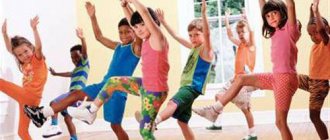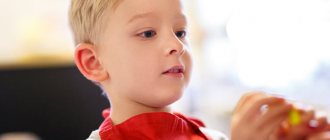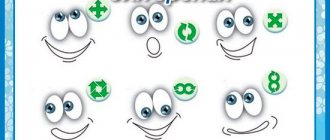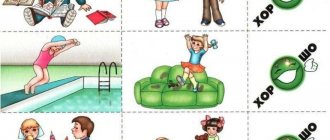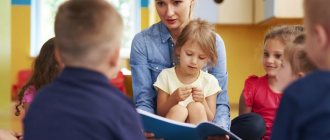Kinesiology is the science of developing our brain through movement. Her methods can be called universal for the development of mental abilities with the help of special motor exercises aimed at synchronizing the work of both hemispheres of the brain. Not only mechanical, but also psychophysiological laws of human development are involved here. Kinesiology helps improve motor coordination and regulate fatigue in dancers, athletes, gymnasts, and manual workers. Do children need such exercises? What are the benefits of kinesiological exercises for the development of preschool children?
What are these exercises used for?
Kinesiology can be called a kind of fusion of the theory and practice of physiotherapy, naturopathy, acupuncture, homeopathy, oriental medicine, chiropractic and other areas of knowledge about our health. It is based on improving the interaction of the brain hemispheres, which leads to overall harmonization in the functioning of body systems.
Using kinesiology exercises allows you to:
- improve health;
- increase tone;
- reduce fatigue, fatigue and irritability;
- improve psycho-emotional state;
- reduce excessive activity;
- increase concentration and mental performance;
- improve memory;
- stimulate the development of hearing and speech;
- improve attention and thinking;
- develop perception, spatial concepts, imagination.
From this we can conclude that kinesiological exercises for preschoolers are no less useful than for adults. Especially for children with various problems (mental disorders, delays in general or speech development, hyperactivity, etc.). With systematic exercise, children become more active, smart, energetic, learn to control their mental processes (negative behavior, irritability, low volition, excitability), improve speech and motor skills, and concentrate better.
Due to such a broad effect, this technique is used by a variety of specialists:
- teachers;
- pediatricians;
- psychologists;
- neuropsychologists;
- defectologists;
- speech therapists.
There are many different exercises to help solve specific problems. Kinesiology in speech therapy, for example, includes the following techniques:
- exercises for general motor activity;
- articulation gymnastics;
- games for the perception and differentiation of sounds and noises;
- games to improve coordination between the right, left hand, tongue, eyes;
- breathing games;
- exercises to consolidate spatial concepts (right, left, in front, behind; closer than; to the right, etc.);
- exercises to develop arbitrariness;
- finger games.
CONSULTATION for PARENTS “KINESIOLOGICAL EXERCISES WITH CHILDREN” consultation
CONSULTATION FOR PARENTS
“KINESIOLOGICAL EXERCISES WITH CHILDREN”
(As part of the project “Learning to actively relax and strengthen health” (Strengthening the health of preschool children through physical recreation). For those who want their child to grow up smart and healthy)
Kinesiology is the science of developing our brain through movement. Her methods can be called universal for the development of mental abilities with the help of special motor exercises aimed at synchronizing the work of both hemispheres of the brain. Not only mechanical, but also psychophysiological laws of human development are involved here
What are the benefits of kinesiological exercises for the development of preschool children? WHAT ARE SUCH EXERCISES USED FOR?
Kinesiology can be called a kind of fusion of the theory and practice of physiotherapy, naturopathy, acupuncture, homeopathy, oriental medicine, chiropractic and other areas of knowledge about our health. It is based on improving the interaction of the brain hemispheres, which leads to overall harmonization in the functioning of body systems. Using kinesiology exercises allows you to: improve health; increase tone; reduce fatigue, fatigue and irritability; improve psycho-emotional state; reduce excessive activity; increase concentration and mental performance; improve memory; stimulate the development of hearing and speech; improve attention and thinking; develop perception, spatial concepts, imagination. From this we can conclude that
Kinesiological exercises for preschoolers are no less useful than for adults. Especially for children with various problems (lag in general or speech development, hyperactivity, etc.). With systematic exercise, children become more active, smart, energetic, learn to control their mental processes (negative behavior, irritability, low volition, excitability), improve speech and motor skills, and concentrate better. Thanks to such a broad effect, this technique is used by a variety of specialists: teachers; pediatricians; psychologists; neuropsychologists; defectologists; speech therapists.
There are many different exercises to help solve specific problems. Kinesiology in speech therapy, for example, includes the following techniques: exercises for general motor activity; articulation gymnastics; games for the perception and differentiation of sounds and noises; games to improve coordination between the right, left hand, tongue, eyes; breathing games; exercises to consolidate spatial concepts (right, left, in front, behind; closer than; to the right, etc.); exercises to develop arbitrariness; finger games.
A LITTLE PHYSIOLOGY. Our brain consists of two hemispheres, each of which performs its own functions, being responsible for the occurrence of certain processes (left - logical, right - creative). Ideally, they harmoniously complement each other. And a person needs the correct work not only of each of them separately, but also in interconnection. So, what is each hemisphere of the brain responsible for?
Left. Helps us highlight the key points in each problem, that is, it is responsible for logical and analytical thought processes, helps us think consistently. In addition, it provides: inductive thinking (analysis occurs first, and then synthesis); processing of verbal information; speech and language abilities; ability to read and write; memorization (poems, names, titles, dates, facts); understanding the literal meaning of the information received; future planning; mathematical inclinations, ability to work with diagrams, tables, formulas, numbers; control of the right side of our body.
Right. Responsible for creative processes and intuition. It helps to understand the situation, sometimes finding non-standard, but at the same time correct solutions. The right hemisphere also ensures: the development of imaginative thinking; orientation in space; ability to solve puzzles, rebuses, creative problems; simultaneous processing of many different blocks of information, consideration of the problem as a whole; deductive thinking (first – synthesis, then – analysis); processing of nonverbal information, which is expressed in images, symbols; remembering images (pictures, voices, poses, faces), perceiving a set of features as a single whole; the ability to understand someone else's figurative speech, sense of humor; perception of emotions, intonation, voice timbre; orientation in the present; development of imagination, fantasy, creative abilities (in particular artistic); distinguishing musical melodies, rhythm, tempo, musical harmony; spontaneous emotions; control of the left half of the body.
Therefore, it is so important that balance is maintained between the functioning of both hemispheres. Kinesiological exercises help to activate the work of all parts of our cerebral cortex and achieve effective interaction between the hemispheres. Their complexes are rightly called “smart gymnastics” or brain gymnastics.
CLASSES WITH CHILDREN In preschool educational institutions, this system is used quite widely. For example, during physical activities, children are offered exercises aimed at coordination between the limbs, eyes, and head. These can be asymmetrical movements (one hand strokes, the other hits), movements performed with closed eyes (touch the nose, ear, stand on one leg), movements performed first alternately with the hand or foot, and then together with both. Drawing lessons may include drawing with the other hand or both hands in a mirror image, drawing with eyes closed, tracing a contour in one direction and then in the other direction with each hand in turn. In speech development lessons, various finger games are widely used, aimed at improving fine motor skills and finger dexterity. In cognitive and play activities, various aids are used to help children master simultaneous coordinated movements with both hands. For example, children 3-4 years old are offered folders with mirror images of various objects. Such applications can consist of buttons, keys, paper or textile parts, geometric shapes, cords, ladders, etc. The child takes turns touching, pressing, tracing each part, first with one hand, then with the other, then with both. At the same time, poetic or musical accompaniment, or the child himself pronouncing actions or poems illustrating them, can act as additional stimulants for other areas of the brain.
Use kinesiology exercises with your baby at home. Below are various examples of activities that help achieve different effects (concentration, relaxation, motor skills). This is especially true if your baby does not attend kindergarten. But otherwise, such classes will not hurt. Even without systematic implementation: they can concentrate the child at the right moment, calm him down, relax him, increase his attention, and set him up for work.
The only thing you need to do for this is to first master each exercise yourself, understand what sensations it causes, what organs it uses, and what results it gives. After this, you will be able to give your preschooler clearer instructions on how to complete each task (feel how tense ..., your eyes should follow ..., the breath should be deep and slow, etc.).
EXAMPLES OF KINESIOLOGICAL EXERCISES
EAR MASSAGE. Both hands simultaneously make identical massage movements on the lobes and shells of the ears, then massage the ears completely, and finally rub them with the palms. The movements must be synchronous.
BRAIN BUTTONS The following three exercises deserve special attention. Performed together, they seem to turn on our body. At the same time, blood circulation in the brain improves, the work of both hemispheres is synchronized, sensory perception improves, and concentration significantly increases. These three simple exercises help relieve mental and nervous tension and focus on remembering something new. This “trio” is very useful for children with hyperactivity. It will not be so easy for a child to complete these tasks, especially if he has no previous experience of such exercises. Therefore, maximum attention and patience will be required from adults. You need to complete all tasks with each hand for about 25–30 seconds.
The index finger of one hand massages the point in the center of the nasolabial fold above the upper lip, the middle finger massages the point under the lower lip - symmetrical to the upper lip. The palm of the other hand is on the navel. When performing such a massage, you need to move your eyes along a square trajectory (from left to top, then from right to bottom). Next you need to change hands and repeat all over again. The index and middle fingers (together) of the left hand apply pressure under the lower lip. The fingers of the other hand massage the tailbone. In the same way, hands need to be changed. We place the palm of one hand on the navel, and the fingers of the other should massage the tailbone. After 20-30 seconds we change hands.
The three previous exercises are well suited for doing at home, especially if the child needs to be quickly calmed down and included in the work. The next few examples are appropriate for homework because the child needs physical assistance from an adult.
1. Let the baby sit on the floor, pull his knees towards him and hug them, burying his head in his knees. Tell him that he is a chicken and will now hatch from his egg into the light. The mother takes on the role of the shell. She sits behind her child and wraps her arms and legs around him. Now the “chick” begins to “hatch”, overcoming the strength of the “shell”.
2. The baby lies on the floor with his back. He needs to feel the floor tactilely with every part of the body (back of the head, neck, shoulders, etc.) and describe in words what he feels (the floor is warm, cold, smooth, lumpy, hard, soft). After this, the mother takes one of the baby’s arms and stretches it a little, then the other arm, then each leg in turn. Now the child imagines that he is a stretched string. He must first stretch both arms to the sides, then both legs, then the right and left parts of the body in turn (the leg, side and arm are stretched).
3.The back remains relaxed and does not arch. The child lies on his back, looks straight ahead, his head is motionless. The mother takes a small bright object and begins to move it in front of the baby’s eyes, first in the main directions, then along the diagonals. The child follows the object without moving his head. At first, the object is at arm's length from the child, then - half as much, and in the end - almost at the bridge of the nose. The exercise is done slowly (to a count of 7), the object is fixed in each extreme position for the same count.
So, kinesiology is the science of the complex mechanisms of interaction between brain structures and methods of their harmonization. By doing kinesiological exercises with your child, you can significantly increase his intelligence precisely by establishing this relationship between parts of the brain.
A little physiology
Our brain consists of two hemispheres, each of which performs its own functions, being responsible for the occurrence of certain processes (left - logical, right - creative). Ideally, they harmoniously complement each other. And a person needs the correct work not only of each of them separately, but also in interconnection.
So, what is each hemisphere of the brain responsible for?
Left.
Helps us highlight the key points in each problem, that is, it is responsible for logical and analytical thought processes, helps us think consistently. In addition, it provides:
- inductive thinking (analysis occurs first, and then synthesis);
- processing of verbal information;
- speech and language abilities;
- ability to read and write;
- memorization (poems, names, titles, dates, facts);
- understanding the literal meaning of the information received;
- future planning;
- mathematical inclinations, ability to work with diagrams, tables, formulas, numbers;
- control of the right side of our body.
Right.
Responsible for creative processes and intuition. It helps to understand the situation, sometimes finding non-standard, but at the same time correct solutions.
The right hemisphere also provides:
- development of imaginative thinking;
- orientation in space;
- ability to solve puzzles, rebuses, creative tasks;
- simultaneous processing of many different blocks of information, consideration of the problem as a whole;
- deductive thinking (first – synthesis, then – analysis);
- processing of non-verbal information, which is expressed in images, symbols;
- remembering images (pictures, voices, poses, faces), perceiving a set of features as a single whole;
- the ability to understand someone else's figurative speech,
- sense of humor;
- perception of emotions, intonation, voice timbre;
- orientation in the present;
- development of imagination, fantasy, creative abilities (in particular artistic);
- distinguishing musical melodies, rhythm, tempo, musical harmony;
- spontaneous emotions;
- control of the left half of the body.
Therefore, it is so important that balance is maintained between the functioning of both hemispheres. Kinesiological exercises help to activate the work of all parts of our cerebral cortex and achieve effective interaction between the hemispheres. Their complexes are rightly called “smart gymnastics” or brain gymnastics.
What is it, application
Interesting! Hippocrates laid the foundations of the science of kinesiology in our time, proposing a theory about the body as an integral structure that constantly interacts with the external environment.
Kinesiology exercise
However, the true founder of science is considered to be Asclepiades, who lived more than two thousand years ago in Ancient Greece.
The interaction of the hemispheres is required for the successful functioning of the child’s brain. The hemispheres are connected by the corpus callosum. It consists of approximately two hundred million nerve fibers woven together. The maturation of the corpus callosum begins in children in preschool age and continues until approximately 7-9 years, depending on the individual characteristics of the child. An imbalance in the functioning of the corpus callosum leads to deterioration in memory, concentration and other problems in the development of the child.
Interesting! This problem can be caused by factors such as the child's delayed maturation or the result of stress.
The benefits of kinesiological gymnastics for children
Kinesiological exercises for preschool children will help normalize brain function and establish connections between the cerebral hemispheres. They will also ensure resistance to stress, good memory and the full development of the child in the future. Under their influence, the child will achieve significant improvements in learning and will be able to learn to manage his emotions. The more intense the load, the more significant the results will be. These exercises will help you see the child’s abilities and talents and eliminate developmental problems. The abilities of the brain will expand and the productivity of its work will increase.
Kinesiological massage
Activities with children
This system is used quite widely in preschool educational institutions. For example, during physical activities, children are offered exercises aimed at coordination between the limbs, eyes, and head. These can be asymmetrical movements (one hand strokes, the other hits), movements performed with closed eyes (touch the nose, ear, stand on one leg), movements performed first alternately with the hand or foot, and then together with both.
Drawing lessons may include drawing with the other hand or both hands in a mirror image, drawing with eyes closed, tracing a contour in one direction and then in the other direction with each hand in turn.
In speech development lessons, various finger games are widely used, aimed at improving fine motor skills and finger dexterity.
In cognitive and play activities, various aids are used to help children master simultaneous coordinated movements with both hands. For example, children 3-4 years old are offered folders with mirror images of various objects. Such applications can consist of buttons, keys, paper or textile parts, geometric shapes, cords, ladders, etc. The child takes turns touching, pressing, tracing each part, first with one hand, then with the other, then with both. At the same time, poetic or musical accompaniment, the child’s own pronouncing of actions or poems illustrating them can act as additional stimulants for other areas of the brain.
Special kinesiology classes are conducted according to a specific scheme.
- First, the children are prepared for the upcoming work. So-called stretching exercises are suitable for this. These are several tasks aimed at maximizing tension and then relaxing certain muscles.
- After the kids are tuned in to completing the adult’s tasks, they are offered several breathing exercises that help develop a sense of rhythm and self-control.
- Next comes an exercise that combines movement with eye tracking. They stimulate the interaction of the hemispheres and relieve muscle tension.
- At the end of the lesson, relaxation tasks are performed to relieve muscle tension and relax the kids.
During systematic exercises, different techniques are used to complicate the exercises:
- acceleration of pace;
- exclusion of visual-speech control (performing exercises with eyes closed, tongue slightly bitten);
- on the contrary - connecting movements of the tongue or eyes to hand movements;
- connection to motor breathing exercises;
- connecting visualization (mental representation of some picture).
Use kinesiology exercises with your baby at home. Below are various examples of activities that help achieve different effects (concentration, relaxation, motor skills). This is especially true if your baby does not attend kindergarten.
But otherwise, such classes will not hurt. Even without systematic implementation: they can concentrate the child at the right moment, calm him down, relax him, increase his attention, and set him up for work. The only thing you need to do for this is to first master each exercise yourself, understand what sensations it causes, what organs it uses, and what results it gives. After this, you will be able to give your preschooler clearer instructions on how to complete each task (feel how tense ..., your eyes should follow ..., the breath should be deep and slow, etc.).
Kinesiology: exercises for children at home
Is it possible to do kinesiological gymnastics at home? Will it also be effective? There is not much difference where to do kinesiological exercises.
Interesting! Under the supervision of a psychologist, kindergarten teacher or parents, the technique will be equally effective and useful. It will help the child develop fully, regardless of the place of classes and the people who conduct them.
How to conduct an effective lesson with a preschool child:
- First you need to prepare your child for hard work. For this, stretching is usually used to help you relax and tune in to the activity.
- This is followed by breathing exercises. They will contribute to the supply of oxygen to the brain and improve the functioning of the respiratory system.
- Oculomotor movements will help strengthen the connection between the two hemispheres.
- Bodily exercises are necessary to develop gross and fine motor skills, improve the child’s concentration, concentration and memory.
- Finally, you should spend some time doing relaxation exercises or a relaxing massage to relieve muscle tension.
Kinesiology is useful for both children and adults. This unique technique can help absolutely anyone improve their physical and psycho-emotional health. By doing kinesiological exercises with your child, you can significantly increase his intelligence by improving the connection between the hemispheres of the brain.
Examples of kinesiology exercises
So, what exercises help achieve that very harmony in the interaction of all structures of our brain? Here are some examples.
- Ear massage. Both hands simultaneously make identical massage movements on the lobes and shells of the ears, then massage the ears completely, and finally rub them with the palms. The movements must be synchronous.
Brain Buttons
The next three exercises deserve special attention. Performed together, they seem to turn on our body. At the same time, blood circulation in the brain improves, the work of both hemispheres is synchronized, sensory perception improves, and concentration significantly increases. These three simple exercises help relieve mental and nervous tension and focus on remembering something new. This “trio” is very useful for children with hyperactivity.
It will not be so easy for a child to complete these tasks, especially if he has no previous experience of such exercises. Therefore, maximum attention and patience will be required from adults.
You need to complete all tasks with each hand for about 25–30 seconds.
- The index finger of one hand massages the point in the center of the nasolabial fold above the upper lip, the middle finger massages the point under the lower lip - symmetrical to the upper lip. The palm of the other hand is on the navel. When performing such a massage, you need to move your eyes along a square trajectory (from left to top, then from right to bottom). Next you need to change hands and repeat all over again.
- The index and middle fingers (together) of the left hand apply pressure under the lower lip. The fingers of the other hand massage the tailbone. In the same way, hands need to be changed.
- We place the palm of one hand on the navel, and the fingers of the other should massage the tailbone. After 20-30 seconds we change hands.
At home, with parents
The three previous exercises are well suited for doing at home, especially if the child needs to be quickly calmed down and included in the work. The next few examples are appropriate for homework because the child needs physical assistance from an adult.
- Let the baby sit on the floor, pull his knees towards him and hug them, burying his head in his knees. Tell him that he is a chicken and will now hatch from his egg into the light. The mother takes on the role of the shell. She sits behind her child and wraps her arms and legs around him. Now the “chick” begins to “hatch”, overcoming the strength of the “shell”.
- The baby lies on the floor with his back. He needs to feel the floor tactilely with every part of the body (back of the head, neck, shoulders, etc.) and describe in words what he feels (the floor is warm, cold, smooth, lumpy, hard, soft). After this, the mother takes one of the baby’s arms and stretches it a little, then the other arm, then each leg in turn. Now the child imagines that he is a stretched string. He must first stretch both arms to the sides, then both legs, then the right and left parts of the body in turn (the leg, side and arm are stretched). The back remains relaxed and does not arch.
- The child lies on his back, looks straight ahead, his head is motionless. The mother takes a small bright object and begins to move it in front of the baby’s eyes, first in the main directions, then along the diagonals. The child follows the object without moving his head. At first, the object is at arm's length from the child, then - half as much, and in the end - almost at the bridge of the nose. The exercise is done slowly (to a count of 7), the object is fixed in each extreme position for the same count.
So, kinesiology is the science of the complex mechanisms of interaction between brain structures and methods of their harmonization. By doing kinesiological exercises with your child, you can significantly increase his intelligence precisely by establishing this relationship between parts of the brain.
Set of exercises
Kinesitherapy exercises for young children are very simple to perform; any child, even 2-3 or 3-4 years old and older, will be able to perform them without much difficulty.
Methods for diagnosing and developing memory in preschool children
Important! Development will be noticeable only if the work is directed from the development of the child’s body to his thinking, and in no case vice versa.
Breathing exercises
Breathing exercises will help develop self-control and improve the respiratory system:
- Candle. The starting position is sitting at the table. The preschooler must imagine that there is a candle in front of him. Then you need to take a big breath and try to blow out the flame of an imaginary candle with a single exhalation. After this, the child needs to imagine 5 small candles in front of him and also try to take a huge breath and blow them out by alternating exhalations.
- Diver. The starting position is standing. Take a deep breath and hold your breath, holding your nose with your fingers. Sit down, imagining that he is diving into the sea. Then count to five, stand up (emerge from the water), remove your hands from your nose and exhale slowly.
- Breathing through the nose. The starting position is standing or lying on your back. Alternately breathe only through the left and then through the other nostril, closing it with the finger of the hand of the same name, the remaining fingers should point their tips upward. Breathing during this exercise should be measured and deep.
Blowing out a candle
Oculomotor exercises
This type of warm-up will improve your vision, visual and kinesthetic perception of the world around you:
- The traveler's eye. The teacher places several pictures in different corners of the room. These can be images of animals, plants, toys, etc. The starting position is standing. The preschooler must, without shaking his head, find with his eyes the picture that the teacher names.
- Eight. Raise your right hand to eye level, clenching your fingers into a fist (the third and second fingers are extended). Draw a large horizontal figure eight (or infinity sign) in front of you. Next, use your tongue, that is, repeat the movement of your fingers with your tongue outstretched together with your eyes.
Eye movement
Bodily exercises
- Flashlight. Put your hands in front of you. Alternately squeeze the fingers of one hand without using the other. Then change hands. Repeat for two minutes.
- Ring. Rotate your fingers alternately and as intensely as possible, connecting the thumb with the index, middle, ring and little fingers, forming a ring. First move in one direction, then in the other. Later, you can complicate the task by performing the exercise with all hands at the same time.
- Fist-rib-palm. Clench your palm into a fist, unclench it and place your straightened hand with a bent finger on the end, straighten your palm completely and place it on a horizontal surface. Repeat 4-5 times.
- Mill. Simultaneous rotation of opposite arms and legs back and forth. Perform together with gaze turns in all directions alternately. Repeat for 1-2 minutes.
- Lezginka exercise for children. The left hand is bent into a fist, one finger points to the left, the fist is turned towards itself. Straighten your right palm and touch it to the little finger of your left hand. Then change hands.
Types of memory in preschool children
